I’m at last beginning to catch up with putting my work on My London Diary, though I’ve still got a few things to do. I’ve already posted here about the pictures that I put on Demotix immediately after the days of protest, but you can now see a wider range of the work that I took on My London Diary.
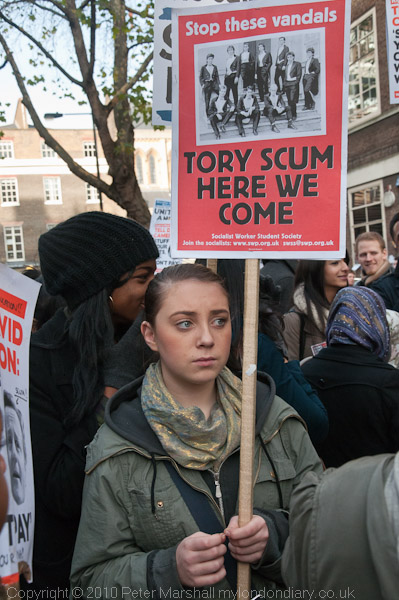
Before the march
On the first of the protests against the cuts on 24 Nov , rather to my surprise (and it was a longer day than I expected too) I took almost 1,500 images, although there are considerably fewer on My London Diary – about 100, or roughly one in 15 of those I took. I don’t normally shoot as many, but there were times when there was a lot of action and I was shooting short bursts of images.
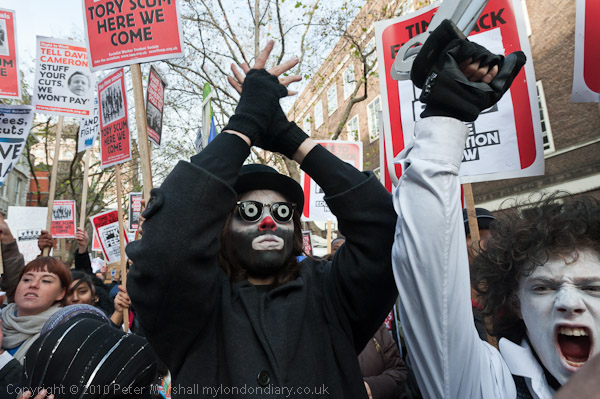
Editing down such a large number of images is a problem, and I’ve been rethinking my workflow a little recently. Lightroom (I’m now using version 3.3) is a great piece of software and I’ve found out a little more about how to use it.
The way I used to work was to import all my images into Lightroom, before starting to select them in the Library Module, where you can rate them in various ways, giving them 1-5 stars or with one of five colours. So usually I went through all the pictures and give those I thought worth processing a 2 star rating. Ones that particularly stand out might get 3 stars. Then I reviewed all those with 2 or more stars to select a small sample to process immediately and send off to Demotix or elsewhere, giving them a colour rating. If I’d shot several events on the same day, I used a different colour for each.
I decided a while back, that it was no longer generally worth sending pictures directly to newspapers – the time I spent simply wasn’t justified by the results, and I wasn’t prepared to make the effort and compromises required to get my pictures there fast enough.
Partly it was a matter of equipment – I seldom take my notebook computer with me when I’m out taking pictures, but more important to me was that I like to select and process my pictures carefully before they are used. I also like to write stories to go with my pictures, and taken together these eliminate my chances of meeting the kind of deadlines papers expect – literally wanting pictures within minutes of being taken (or even seconds with some events.) My pictures do sometimes get into the papers, but not as urgent news.
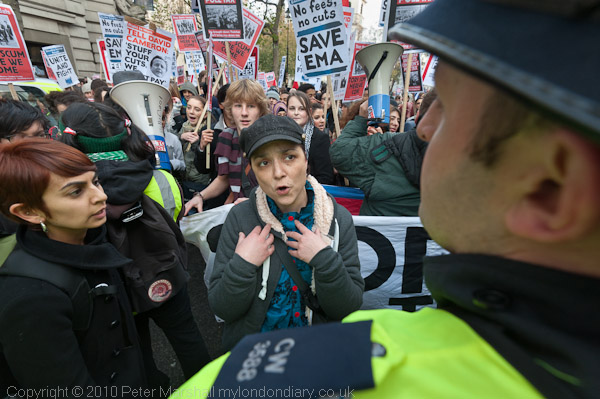
Clare Solomons argues unsuccessfully with police to let the march continue along Aldwych
So uploading the whole contents of the memory cards from a particular event into Lightroom isn’t usually a problem, though it can take quite a while. It gives me time to do other things – like research and write a story to go with them, or even have some dinner.
Often while I’m travelling home to do this, I have time to do a quick edit using the screen on the back of the camera, but I find this too small for most purposes. It does enable you to delete the really hopelessly exposed or framed images, and you can zoom in to check for sharpness, but not really a great deal more.
Recently I’ve started to do a more rigorous selection on the computer before importing the images, reading them while still on the card. The import dialogue in Lightroom enables you to view the images still on the card either as thumbnails in a grid or singly, and to decide whether or not to import each of them. Just as in the Library grid view you can also zoom into the images and check sharpness too. It isn’t perfect – and I’d like it to actually start the import as you are making the decisions rather than do it as a batch when you have completed your review.
There are also quite a few pictures that I’m unsure about because the default jpeg that Lightroom presumably reads from the RAW file isn’t good enough, and which need a certain amount of processing before you can decide if they are worth keeping. It’s actually easier to do the review of these once they have been imported into Lightroom, as the processing in my import preset usually helps, and in any case the Library module allows you to quickly apply some rough processing – such as increasing or decreasing exposure.
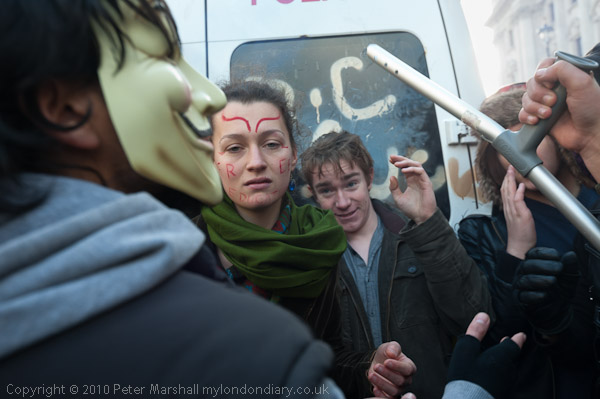
Protesters try to stop others falling into a police trap by smashing the van
Lightroom is sometimes just a little slow at viewing them on my computer (which at more than 3 years old is beginning to show its age) but overall I find quite a saving in time if I can drastically cut the number than I import. It also of course saves storage space – those 1500 images are about 11 Mb each, and would occupy around 16 Gb on the hard disk – or 4 DVDs for a backup. So unlike working on film where everything got files, I’m moving to a more selective approach. Of course had I been using film I would have shot less, worried about running out of film – and I seldom used more than a dozen 36 exposure cassettes – about 450 frames.
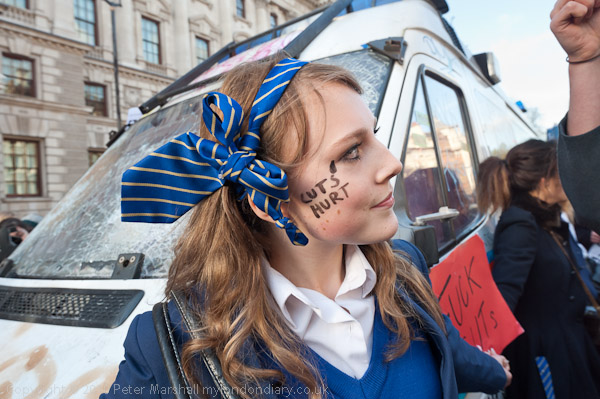
A school student tries to protect the van from further damage
Until now I’ve kept almost every file that I created with the digital camera, worried that I might miss something important. Now, having imported those files that I selected I go back and open the import dialogue again, making sure that I’ve ticked the checkbox not to import duplicates. I can then check through the pictures again, more rapidly as thumbnails in grid view (I use the slider to make the thumbnails as large as possible) and import any that I missed first time, before removing the card and putting it back in the camera. The pictures will stay there just in case I want to find something else from among them until I format the card, usually on my way to the next event.
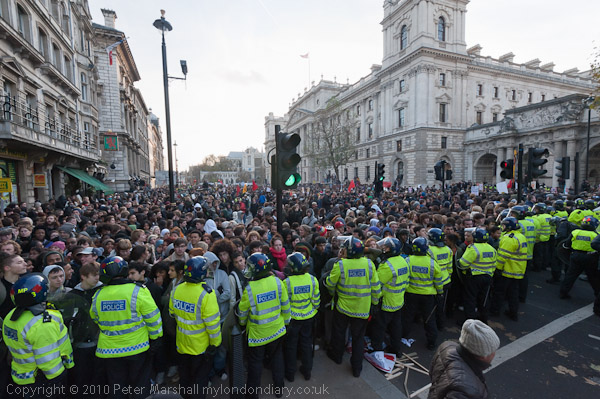
The kettle. Police were letting a few people, mainly young girls, leave at this point.
The pictures here are just a few of mine from the day that I don’t think have been used anywhere other than in my own story, now on My London Diary, with a fairly large set of images including these.